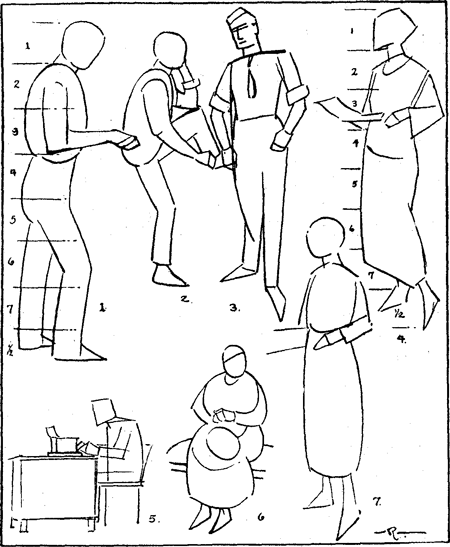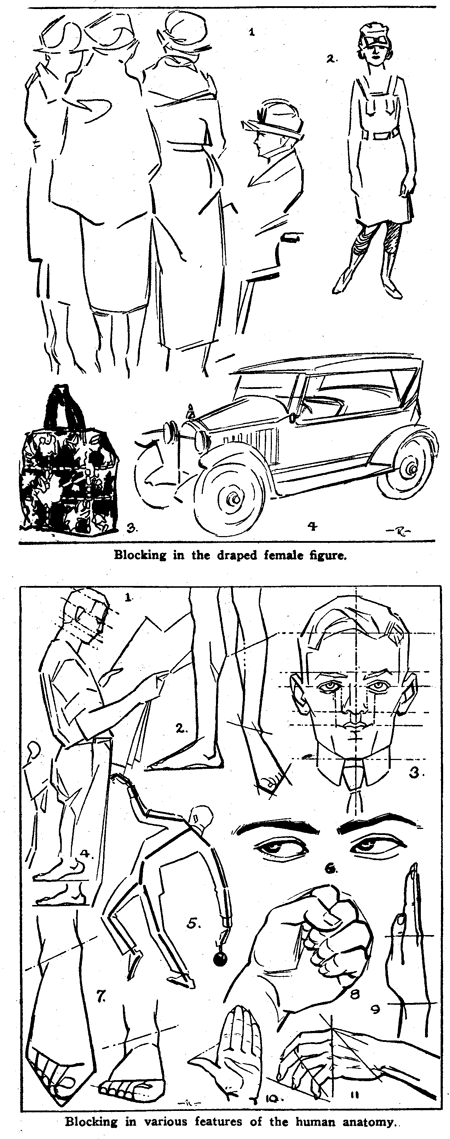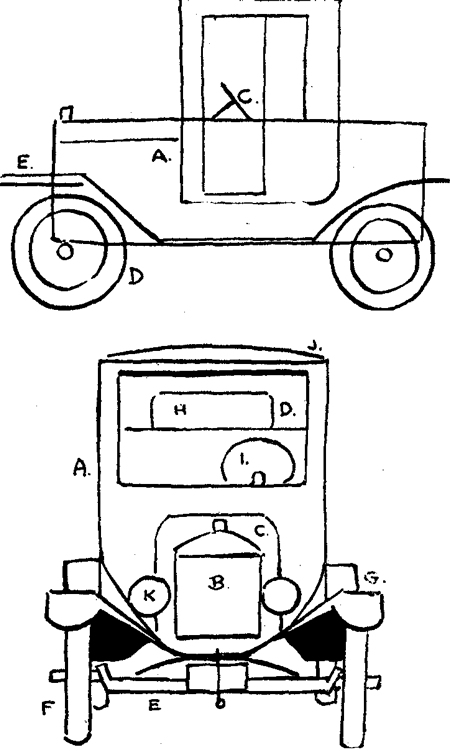Home > Directory of Drawing Lessons > How to Improve Your Drawings > Blocking-In Forms > Learn the Shortcuts to Drawing : Block-In Shapes
LEARN SHORTCUTS TO DRAWING : blocking-in Method of Drawing forms & Shapes first
|
|
BLOCKING-IN METHODS : Short Cuts to Drawing When you have gained an idea of the construction of the skeleton and skull, the next step will be to learn to block in a sketch. You will know that the arm does not bend between the shoulder joint and the elbow, nor between the elbow and the wrist.
Likewise you will know that the distance between the elbow and the middle finger joints is the same as the distance between the elbow and the top of the shoulder, as you can demonstrate by flexing your arm, You should make your drawing of an arm conform to this natural fact. Furthermore, you will have learned that the elbow reaches to the hip, and that the tip of the fingers reach to the middle of the femur (upper leg) —not to the knee. All this will come with a knowledge of the skeleton and will help you to become a skilled draftsman.
On this page are several tips which will make it easier for anyone to draw quickly and correctly. Note how I block in the figure of the youth reading the paper, and indicate the angles at which the body bends. The head is bent, and with it the angles at which the ear, mouth, eyes, etc., go likewise, as the dotted lines indicate. The rest of the figure is fitted around the skeleton which, of course, is erased. The legs and feet are blocked in with angles. The feet, front view, are made with three angles (four I show) , as you see, and the profile with three angles. The inner ankle bone is always higher than the outer. The inner lower leg bone suggests itself and aids in showing where the calf starts.
The head shows how to locate correctly and keep in line all the features of the face. You draw a large "O"-shaped block, then a line down the center (this is a front view) ; next a line a bit above the horizontal center, which will be the location of the average person's eyebrows. Not all heads will fit this form of measurement, you will quickly discover. Across the middle will be the eyes. Between the eyebrows and the top of the hair will begin the forehead—ordinarily one-third down from the top of the head. From the eyebrows to the nose base is about the same distance as is the distance between the top of the forehead and the eyebrows (varying with individuals). In most individuals the distance between the tip of the nose and the bottom of the chin is a bit longer than the nose and forehead lengths just mentioned. In many persons the face seems to be divided in three parts of equal length—the top of the forehead to the base (or eyebrows) ; the eyebrows to the tip of the nose, and the tip of the nose to the bottom of the chin. From the nose tip the mouth will be about one-third the distance between the nose and the base of the chin. The corners of the mouth come on a line dropped from inside the middle of the eyes, as shown by the dotted lines. The outer rim of the lobes of the nose comes directly under the corners of the eyes. The highest point of the lips come under their respective nostrils. The ears vary, according to size, but the average ear extends from a bit below the eyebrow line to the center, between the tip of the nose and the top of the mouth. The eyes are always an eye's distance apart. The upper lid is usually drawn more heavily, as it casts a shadow, while the lashes also make it a darker line. The eyeball is round, and the lids cover it. The lids are thick; therefore, when a light shines on the lower lid it is best shown by drawing the cornea (pupil) and allowing distance to show between it and the lower lid outer line. Curve around the ball of the eye at the inner corner to give an appearance of roundness. Always leave a high light in the eyes, since it puts a touch of life into the countenance. The fingers always turn in toward the center of the palm, as you will observe in a closed hand. The thumb always reaches to midway between the inside first joint of the index finger. A life-size head is easiest measured on paper by marking the distance between the tip of the thumb (outstretched) and the tip of the index finger. This is the distance between the top of the forehead and the bottom of the chin. Also the entire hand, from the wrist to the finger tips, covers the same distance. This same principle of blocking in can be applied to drawing such objects as automobiles. The object drawn should first be seen as a mass — not as long and short lines, but as squares, circles, triangles, etc. For example, gaze out of your window at an automobile standing across the street. If it is a Ford sedan, say, it will appear to you like a low, oblong square (somewhat coffin shaped). In the center is another square — an upright, tube shaped, taller square (the cab). There are two complete circles and two partial circles to be added to this coffin-shaped square. These circles will be the tires. Lay this out as noted in the accompanying sketch. This will enable you to have your drawing laid out in proportion, quickly, and, unlike the methods otherwise employed in making such a drawing, you will not have finished or nearly finished your drawing only to discover that you have made one part of your automobile either too long or too short. Then draw in the details of the car correctly, paying particular attention to perspective.
|
Privacy Policy ...... Contact Us







